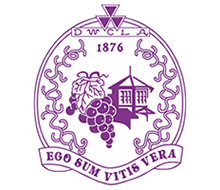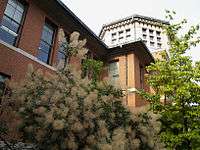Doshisha Women's College of Liberal Arts
| 同志社女子大学 | |
 Emblem | |
| Motto | Latin: Ego sum vitis vera |
|---|---|
Motto in English | I am the true vine |
| Type | Private |
| Established |
Founded 1876 Chartered 1949 |
| President | Hirō Kaga |
Academic staff | 836 |
Administrative staff | 251 |
| Students | 6,538 |
| Undergraduates | 6,466 |
| Postgraduates | 52 |
| Location |
Kyoto, Kyoto, Japan 35°01′47″N 135°45′49″E / 35.029629°N 135.763613°ECoordinates: 35°01′47″N 135°45′49″E / 35.029629°N 135.763613°E |
| Campus |
Urban / Suburban, 530 acres (2.1 km²) |
| Colors | White and Purple |
| Nickname | Dojo (同女 Dōjo) |
| Website |
www |
Doshisha Women's College of Liberal Arts (同志社女子大学 Dōshisha joshi daigaku) is a private women's college in Kyotanabe, Kyoto, Japan. The predecessor of the school was founded in 1876, and it was chartered as a university in 1949.
History
In 1876, Protestant educator Niijima Jō founded the Doshisha Girls' School with the assistance from his wife Niijima Yae.[1] The original school was located at the former residence of Yanagihara family (a division of Fujiwara clan) inside the Kyoto Imperial Palace. Since the main Doshisha University founded the year prior was not co-educational at the time, the women's school was founded to promote the importance of women's education.
In 1930, it was renamed to Doshisha Women's College and maintained as a vocational school. In 1949, the vocational system was abolished, and the school was granted university status and the present name under the new National School Establishment Law.[2]
Faculties, Departments and Graduate Schools
- Faculties and Departments [Undergraduate Levels]
- Faculty of Liberal Arts
- Department of Music (Music Performance / Theoretical Studies in Music)
- Department of Information and Media
- Department of International Studies
- Faculty of Contemporary Social Studies
- Department of Social Systems Studies
- Department of Childhood Studies
- Faculty of Pharmaceutical Sciences
- Department of Clinical Pharmacy
- Faculty of Nursing
- Department of Nursing
- Faculty of Culture and Representation
- Department of English
- Department of Japanese Language and Literature
- Faculty of Human Life and Science
- Department of Human Life Studies
- Department of Food Science and Nutrition (Food Science / Nutrition and Dietetics)
- Faculty of Liberal Arts
- Graduate Schools
- Literary Studies
- English (M.A. and Ph. D degrees)
- Japanese Studies (M.A. and Ph. D degrees)
- Information and Culture Studies (M.A. degree)
- International Social Systems Studies
- International Social Systems Studies (M.A. degree)
- Pharmaceutical Sciences
- Clinical Pharmaceutical Sciences (Ph. D degree)
- Human Life and Science
- Life Style Design Studies (M.A. degree)
- Food and Nutrition Studies (M.S. degree)
- Literary Studies
- As of 2013, Doshisha Women's College of Liberal Arts employs 278 full-time and 553 part-time faculty members across its Kyoto campuses.[3]
Campuses


| Wikimedia Commons has media related to Doshisha Women's College of Liberal Arts. |
Kyoto
Doshisha Women's College has two campuses at Kyotanabe in southern Kyoto and at Imadegawa in central Kyoto. Kyoto, Japan’s ancient capital from 794 to 1867 (there are various theories regarding the last year), has a 1,200-year history and attracts tourists from around the world. Traditional culture and arts such as tea ceremony and flower arrangement have developed and have been preserved in Kyoto. The city has hundreds of Buddhist temples and Shinto shrines, including some designated as World Cultural Heritages, where many festivals such as Aoi Matsuri, Gion Matsuri and Jidai Matsuri are held throughout the year. At the same time, Kyoto is a highly modern city, home to many of Japan’s leading high-tech industries and a thriving international community.
Kyotanabe Campus
The Kyotanabe campus is located in Kyōtanabe, Kyoto. It was opened in 1986 as Tanabe campus, part of the Kansai Science City until it was renamed in 1999.[1] The campus now houses 4 faculties (Faculties of Liberal Arts, Contemporary Social Studies, Pharmaceutical Sciences and Nursing ) and 3 graduate schools.[4]
Imadegawa Campus
The Imadegawa campus is located in the former residences of Nijō family and Fushimi-no-miya, situated in the center of Kyoto City, across from Kyoto Imperial Palace. It is located adjacent to the Imadegawa campus of Doshisha University. Inside the campus, the two buildings James-kan (built in 1913) and Eiko-kan (built in 1932) are registered as Tangible Cultural Properties of Japan.[5] This campus houses 2 faculties (Faculties of Culture and Representation and Human Life and Science) and 2 graduate schools.[4]
Student life
While the pursuit of knowledge is the fundamental principle behind all higher learning academies, it is also essential that universities support and guide students toward personal development. At Doshisha Women’s College, students are encouraged to independently plan and actively participate in various club activities and events. These include religious retreats, summer / spring camps, sports festivals, assemblies, and the college’s two unique events: the “Doshisha Eve” and “Shakespeare Eve”. Through these extracurricular programs, the college hopes to inspire and foster a spirit of cooperation and independence among young women.
Festivals
- Doshisha Eve - Held to coincide with and commemorate the Doshisha’s Foundation Day, the occasion of “Doshisha Eve” , the college festival, offers a variety of lectures, concerts, performances, exhibitions, and outdoor booths. This festival is held for three days prior to November 29, the founding date of Doshisha, at the Imadegawa campus.[6]
- Shakespeare Eve - An especially unique event is “Shakespeare Eve”, held annually in November on the Imadegawa campus. Fourth-year students from the Department of English independently produce, promote, and perform a Shakespearean play.[7]
Club Activities
There are a total of 53 official clubs and circles as extracurricular activities (as of Apr. 1, 2015). These clubs are classified into four categories: Religious Club, Cultural Club, Sports Club, and Circle.
- Religious Club: Joyous Bells, Choir etc. (4 clubs)
- Cultural Club: Announce Club, Cinema Club, Kado (Ikebana) Club, Kimono Club, Mandolin Club, and Sado (Japanese Tea Ceremony) Club etc. (25 clubs)
- Sports Club: Archery Club, Basketball Club, Dance Club, Flamenco Club, Canoe (Kayak) Club, Tennis Club, and Kyudo Club etc. (21 clubs)
- Circle: Sports fan, and Messiah Choir etc. (3 circles)
Alumni
As of 2012, around 11.6% of undergraduates were able to find employment in one of the top 400 companies in Japan, which places them third overall among women's universities in Kansai area, after Nara Women's University and Kobe College.[8]
List of Partner Universities and Colleges
United States of America (14 institutions)
 Chatham University(Pennsylvania, U.S.A)
Chatham University(Pennsylvania, U.S.A) Emporia State University(Kansas, U.S.A)
Emporia State University(Kansas, U.S.A) INTO Oregon State University(Oregon, U.S.A)
INTO Oregon State University(Oregon, U.S.A) Mary Baldwin College(Virginia, U.S.A)
Mary Baldwin College(Virginia, U.S.A) Marylhurst University(Oregon, U.S.A)
Marylhurst University(Oregon, U.S.A) Millikin University(Illinois, U.S.A)
Millikin University(Illinois, U.S.A) Smith College(Massachusetts, U.S.A)
Smith College(Massachusetts, U.S.A) Sweet Briar College(Virginia, U.S.A)
Sweet Briar College(Virginia, U.S.A) University of Arkansas, Fort Smith(Arkansas, U.S.A)
University of Arkansas, Fort Smith(Arkansas, U.S.A) University of California, Irvine(California, U.S.A)
University of California, Irvine(California, U.S.A) University of California, Riverside(California, U.S.A)
University of California, Riverside(California, U.S.A) University of Massachusetts Amherst(Massachusetts, U.S.A)
University of Massachusetts Amherst(Massachusetts, U.S.A) University of Nebraska at Kearney(Nebraska, U.S.A)
University of Nebraska at Kearney(Nebraska, U.S.A) Wells College(New York, U.S.A)
Wells College(New York, U.S.A)
Canada (11 institutions)
 Acadia University(Nova Scotia, Canada)
Acadia University(Nova Scotia, Canada) Algoma University(Ontario, Canada)
Algoma University(Ontario, Canada) Mount Allison University(New Brunswick, Canada)
Mount Allison University(New Brunswick, Canada) Saint Mary's University(Nova Scotia, Canada)
Saint Mary's University(Nova Scotia, Canada) St. Thomas University(New Brunswick, Canada)
St. Thomas University(New Brunswick, Canada) Trent University(Ontario, Canada)
Trent University(Ontario, Canada) University of Alberta(Alberta, Canada)
University of Alberta(Alberta, Canada) University of Manitoba(Manitoba, Canada)
University of Manitoba(Manitoba, Canada) University of Victoria(British Columbia, Canada)
University of Victoria(British Columbia, Canada) University of Winnipeg(Manitoba, Canada)
University of Winnipeg(Manitoba, Canada) Vancouver Island University(British Columbia, Canada)
Vancouver Island University(British Columbia, Canada)
United Kingdom (11 institutions)
 INTO Newcastle University(England, U.K)
INTO Newcastle University(England, U.K) Lancaster University(England, U.K.)
Lancaster University(England, U.K.) Oxford Brookes University(England, U.K.)
Oxford Brookes University(England, U.K.) Queen's University Belfast(Northern Ireland, U.K.)
Queen's University Belfast(Northern Ireland, U.K.) Royal Holloway, University of London(England, U.K.)
Royal Holloway, University of London(England, U.K.) University of Bradford(England, U.K.)
University of Bradford(England, U.K.) University of East Anglia(England, U.K.)
University of East Anglia(England, U.K.) University of Essex(England, U.K.)
University of Essex(England, U.K.) University of Exeter(England, U.K.)
University of Exeter(England, U.K.) University of Leeds(England, U.K.)
University of Leeds(England, U.K.) University of Warwick(England, U.K.)
University of Warwick(England, U.K.)
Australia (5 Institutions)
 Deakin University(Victoria, Australia)
Deakin University(Victoria, Australia) Griffith University(Queensland, Australia)
Griffith University(Queensland, Australia) University of Melbourne(Victoria, Australia)
University of Melbourne(Victoria, Australia) University of Wollongong(New South Wales, Australia)
University of Wollongong(New South Wales, Australia) UNSW Global Pty Limited(New South Wales, Australia)
UNSW Global Pty Limited(New South Wales, Australia)
New Zealand (1 institution)
 Victoria University of Wellington(New Zealand)
Victoria University of Wellington(New Zealand)
Germany (1 institution)
 Universität des Saarlandes(Saarlandes, Germany)
Universität des Saarlandes(Saarlandes, Germany)
China (2 institutions)
 Peking University(China)
Peking University(China) Xi'an Jiaotong University(China)
Xi'an Jiaotong University(China)
Taiwan (2 institutions)
 Providence University(Taiwan)
Providence University(Taiwan) Soochow University(Taiwan)
Soochow University(Taiwan)
Korea (1 institution)
 Seoul Women's University(Korea)
Seoul Women's University(Korea)
Thailand (1 institution)
 Thammasat University(Thailand)
Thammasat University(Thailand)
See also
References
- 1 2 "Doshisha University Collection, 1914-present". Amherst College. Retrieved August 6, 2013.
- ↑ "Timeline". Doshisha Women's College of Liberal Arts. Retrieved August 6, 2013.
- ↑ "学生数・教職員数一覧". 同志社女子大学. Retrieved August 6, 2013.
- 1 2 "Undergraduate and Graduate Programs". Doshisha Women's College of Liberal Arts. Retrieved August 6, 2013.
- ↑ "国・登録有形文化財". Kyoto City Official Website. Retrieved March 6, 2016.
- ↑ "EVE (大学祭)". 同志社女子大学. Retrieved August 6, 2013.
- ↑ "同志社女子大学表象文化学部英語英文学科". シェイクスピア・プロダクション. Doshisha Women's College of Liberal Arts. Retrieved 23 February 2016.
- ↑ "2012年 大学別著名400社 就職率ランキング 女子大学編". 大学通信. Retrieved August 6, 2013.